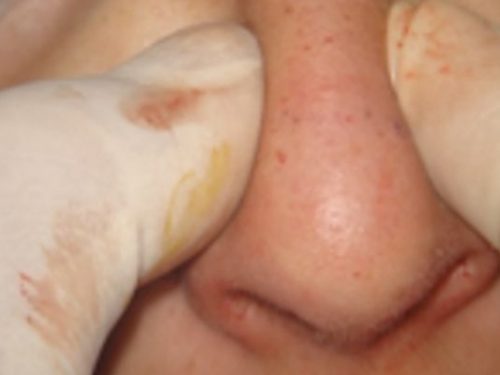
Regenerative Medicine for Management of Neglected Congenital Muscular Torticollis.
Surgical management of neglected or relapsing Congenital Muscular Torticollis has traditionally consisted on cutting sternocleidomastoid muscle at different levels. Dr. Juan Monreal has developed an innovative technique based on the principles of regenerative medicine, ie regenerate the muscle to make it as normal as possible.
What it is congenital muscular torticollis ?.
Congenital Muscular Torticollis is a pathological condition which presents with progressive fibrosis of sternomastoid muscle in one or both sides of the neck. As a result thereof, the muscle undergoes different degrees of atrophy and contracture which causes permanent asymmetries and malpositions of the neck and face. Congenital Muscular Torticollis is the third most common congenital malformation after hip dysplasia and clubfoot.
Diagnosis of Congenital Muscular torticollis.
Congenital Muscular Torticollis is usually diagnosed at birth or soon after birth after discovering one or more of the following signs:
- Malposition of the neck and face of the newborn. Progressive fibrosis (scarring) of the muscle causes its contraction, which in turn causes a deformity in the position of the neck and face. The head is tilted toward the affected side and the chin deviates to the opposite side.
- Sometimes affected muscle presents with a bulge at some point along the muscle belly.
- Different degrees of bone asymmetry of the face and skull.If not properly treated neck and facial deformities becomes permanent and increasingly apparent.
Treatment of Congenital Muscular torticollis.
The treatment of congenital muscular torticollis consists of:
- Physical therapy, which is effective in the vast majority of patients if started within the first months of life. Physiotherapy loses effectiveness after the first year of life and especially after the fourth year.
- Surgical treatment becomes the first line of treatment after the first year of life, with varied success rates according to the technique used and the surgeon’s experience. Traditionally all surgical techniques used to treat congenital muscular torticollis adheres to one of the following principles:
– Endoscopic assisted sectioning of the muscle belly at midpoint area.
– Release of muscle insertions into clavicle and/or the area located behind the ear (unipolar or bipolar release). Surgical lengthening of the muscle is usually performed at the same time.
– In severe cases some surgeons opt for the complete removal of the affected muscle.
Except for endoscopic assisted techniques muscle cutting must be performed through skin incisions located above the clavicle and/or behind the ear. These techniques are intended to release the tension generated by muscle contraction-fibrosis thus correcting posture of the neck and face (this is much like cutting a tensioning rope). Although all aforementioned techniques have been used safely for many years the overall recurrence rate of the deformity is no less than 11% and usually do not provide any improvement in neck or face symmetry.
New regenerative therapy for neglected congenital muscular torticollis.
Since improvement in torticollis must be provided by improvement in muscle thickness, length and functionality, Dr. Juan Monreal has developed an innovative protocol to try to achieve this goals without the need to make cuts or incisions, thereby preventing more efficiently a relapse in deformity. The procedure is performed under general anesthesia since muscle must be totally relaxed and neck easily manipulated. During surgery the scarred muscle areas are released and simultaneously injected with fat fragments «supercharged» with regenerative cells. This treatment is able to expand and thicken the damaged muscles allowing the patient to recover no less than 90% of mobility within weeks. Due to the absence of major postoperative discomfort or skin-muscle incisions the patient finds it much easier to reeducate neck posture, flexibility and mobility. Returning to daily activities occurs in two or three days as there are minor discomfort and no wounds or stitches.
After nearly 10 years of patient followups results are aesthetically and functionally stable with no relapses. To date of writing of this article Dr. Monreal has treated 36 patients aged from 4 to 37 years.
Dr. Monreal presented this novel technique for the first time in the world during the IFATS Meeting held in New York on November 30th, 2013. You can read his first journal article describing his technique here.
Additional information.
Click here if you want to read more about Dr. Juan Monreal and access some of his published articles. You can use the search field below to perform a PubMed search.
You can find more information about regenerative medicine in the following selected articles.
- Monreal J.: Aesthetic and Functional Recovery of Congenital Muscular Torticollis Treated with Intramuscular Fat Grafting
- Functional and Aesthetic Recovery of Congenital Muscular Torticollis with Intramuscular Stromal Vascular Fraction Enriched Fat Grafting. Cureus 9(1): e975. doi:10.7759/cureus.975
- Adipose-Derived Cells (Stromal Vascular Fraction) Transplanted for Orthopedical or Neurological Purposes: Are They Safe Enough?
- Human adipose-derived stem cells: isolation, characterization and applications in surgery
- Myogenic potential of adipose-tissue-derived cells
- Transplantation of Adipose Tissue-Derived Stromal Cells Increases Mass and Functional Capacity of Damaged Skeletal Muscle













Comments (0)